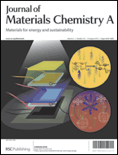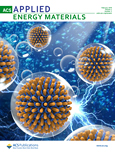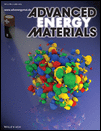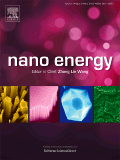
Journal of Materials Chemistry A
Scope & Guideline
Catalyzing Innovations in Chemistry and Materials Science
Introduction
Aims and Scopes
- Energy Materials:
Research related to the development and optimization of materials used in energy storage and conversion systems, including batteries, supercapacitors, and fuel cells. - Photocatalysis and CO<sub>2</sub> Utilization:
Studies focused on materials and systems that capture and convert CO<sub>2</sub> into useful products, utilizing light-driven processes and photocatalytic mechanisms. - Nanomaterials and Nanostructures:
Exploration of nanostructured materials for enhancing performance in various applications, including sensors, catalysts, and electronic devices. - Electrocatalysis:
Investigation of materials that promote electrochemical reactions, particularly those related to hydrogen evolution, oxygen reduction, and nitrogen fixation. - Sustainable and Green Materials:
Development of environmentally friendly materials, including biodegradable polymers, and strategies for recycling and reusing materials. - Interface Engineering:
Research into the design and modification of material interfaces to improve performance in energy devices and catalysis. - Machine Learning in Materials Science:
Application of machine learning techniques to predict material properties, optimize synthesis processes, and enhance materials discovery.
Trending and Emerging
- Flexible and Wearable Electronics:
Research in flexible electronics has gained momentum, focusing on materials that can be integrated into wearable devices, enhancing comfort and functionality. - Solid-State Batteries:
Significant interest in solid-state battery technologies is emerging, driven by the need for safer, more efficient energy storage solutions. - Electrocatalysts for Sustainable Processes:
The development of electrocatalysts for energy conversion and storage, particularly in CO<sub>2</sub> reduction and hydrogen production, is gaining traction. - Advanced Characterization Techniques:
There is an increasing emphasis on sophisticated characterization methods, such as in situ and operando techniques, to better understand material behavior under real-world conditions. - Machine Learning and AI in Materials Discovery:
The integration of machine learning and artificial intelligence in materials discovery is trending, facilitating the rapid identification and optimization of new materials. - CO<sub>2</sub> Utilization and Carbon Capture:
Research focusing on innovative materials for CO<sub>2</sub> capture and conversion into value-added products is increasingly prominent. - Multifunctional Materials:
The trend towards developing multifunctional materials that serve multiple purposes in energy and environmental applications is gaining traction.
Declining or Waning
- Conventional Organic Photovoltaics:
Research on traditional organic photovoltaic materials has seen a decrease as newer technologies and materials, such as non-fullerene organic solar cells, gain prominence. - Legacy Battery Technologies:
Focus on older battery technologies, such as lead-acid batteries, has diminished in favor of advanced lithium-ion and emerging battery systems. - Basic Synthesis Methods:
There is a waning interest in conventional synthesis methods without innovative modifications, as the field shifts towards more complex and tailored approaches. - Single-Use Materials:
Research on materials designed for single-use applications is declining as sustainability and recyclability become more critical in materials development. - Passive Materials:
The focus on entirely passive materials with limited functionality is decreasing, as there is an increasing demand for multifunctional and responsive materials.
Similar Journals

Carbon Energy
Leading the charge in carbon energy research and innovation.Welcome to Carbon Energy, an esteemed open-access journal published by WILEY that focuses on cutting-edge research in the field of energy and materials science. Since its inception in 2019, this journal has quickly established itself as a leading platform for disseminating impactful findings and innovations related to carbon-based energy solutions, renewable resources, and sustainability practices. With its impressive Q1 rankings in multiple categories—including Energy (miscellaneous), Materials Chemistry, and Renewable Energy—Carbon Energy is recognized for delivering high-quality, peer-reviewed content that meets the rigorous standards of the academic community. Through its open-access model, the journal ensures wide accessibility of research findings, making it an invaluable resource for researchers, professionals, and students alike. As we look toward the future, Carbon Energy aims to further its mission of advancing sustainable energy technologies and promoting interdisciplinary collaboration in tackling global energy challenges.

Energy Material Advances
Leading the Charge in Energy Material DiscoveriesEnergy Material Advances, published by the American Association for the Advancement of Science, stands at the forefront of energy research, showcasing groundbreaking studies in the realm of renewable energy, fuel technology, and materials science. With the journal's commitment to open access since 2020, it aims to democratize knowledge and foster innovation across a global community of researchers, professionals, and students. The journal boasts an impressive impact factor, placing it firmly within the Q1 category across multiple disciplines including Energy (miscellaneous), Fuel Technology, and Renewable Energy, Sustainability and the Environment, highlighting its significance in advancing scholarly discussions. In the latest Scopus rankings, Energy Material Advances ranks among the top 10% of journals in its field, affirming its role as a pivotal resource for current and emerging trends in energy materials. The journal is dedicated to facilitating collaborative efforts and inspiring novel approaches to the challenges posed by energy sustainability and technological advancement.

ACS Applied Energy Materials
Connecting Ideas to Drive Energy InnovationACS Applied Energy Materials, published by the American Chemical Society, is a premier journal dedicated to the cutting-edge fields of energy materials, chemical engineering, and electrochemistry. With an impressive impact factor and consistently ranked in the Q1 category across multiple disciplines—including Chemical Engineering, Electrical and Electronic Engineering, and Materials Chemistry—this journal serves as a pivotal platform for researchers and professionals focused on innovative solutions for energy systems and materials science. Since its inception in 2018, ACS Applied Energy Materials has been committed to disseminating high-quality research that addresses pressing energy challenges, promoting sustainability and efficiency in various applications. Its competitive Scopus rankings reflect the journal's influence and relevance within the academic community, making it an essential resource for anyone looking to stay at the forefront of energy materials research.

Advanced Energy and Sustainability Research
Empowering Research for a Sustainable FutureAdvanced Energy and Sustainability Research is a leading open-access journal published by WILEY since 2020, dedicated to advancing knowledge and understanding in the realms of energy and sustainability. With an impressive impact factor and a commitment to high-quality, peer-reviewed research, this journal serves an international audience of researchers, professionals, and students passionate about addressing critical environmental challenges. The journal encompasses a wide array of topics within environmental science and energy fields, securing notable rankings in Scopus with top percentiles across several categories, including Ecology, Energy Engineering and Power Technology, and Waste Management. Given its open-access model, Advanced Energy and Sustainability Research facilitates the dissemination of cutting-edge research, enhancing accessibility and fostering collaboration within the scientific community. This journal not only plays a pivotal role in shaping public policy and industry practices but also aims to inspire innovative solutions for sustainable development in an increasingly complex world.

Science China-Chemistry
Advancing the Frontiers of Chemical KnowledgeScience China-Chemistry, published by SCIENCE PRESS, stands as a leading journal in the field of chemistry, specifically recognized for its contributions in miscellaneous chemistry domains. With an impressive Q1 categorization in the 2023 quartiles and ranking at #35/408 in general chemistry by Scopus, this journal places itself within the top 91st percentile, showcasing its significant impact in the discipline. The journal, based in Beijing, China, provides a platform for innovative research, reviews, and insights that cater to an international audience of researchers, professionals, and students dedicated to advancing chemical science. As an open-access journal, it ensures widespread dissemination of knowledge, making cutting-edge research accessible to all. With converged years from 2010 to 2024, the journal continues to be a vital resource for those engaged with the latest developments in chemistry.

Frontiers of Materials Science
Empowering Researchers with Open Access to Materials ScienceFrontiers of Materials Science is a groundbreaking journal dedicated to exploring advanced materials and their applications within the ever-evolving landscape of materials science. Published by HIGHER EDUCATION PRESS, this journal offers a crucial platform for scholars and practitioners seeking to disseminate innovative research findings that foster interdisciplinary collaboration. Since its inception in 2011, the journal has enjoyed a notable Q2 ranking in the category of Materials Science (miscellaneous) as of 2023, positioning it among the noteworthy publications in the field with a Scopus rank of #222 out of 463. While predominantly published in China, the journal is committed to open access principles, allowing global accessibility to cutting-edge research. With its comprehensive coverage spanning materials synthesis, characterization, properties, and applications, Frontiers of Materials Science not only serves as a repository for academia but also bridges the gap between research and industry, making it an indispensable resource for researchers, professionals, and students alike.

Advanced Energy Materials
Transforming Energy Research for a Sustainable TomorrowAdvanced Energy Materials is a leading academic journal published by WILEY-V C H VERLAG GMBH, focusing on the rapidly evolving fields of materials science and renewable energy technologies. With an impressive impact factor and recognition as a top-tier journal, it ranks within the Q1 category in both Materials Science (miscellaneous) and Renewable Energy, Sustainability and the Environment as of 2023. Spanning from 2011 to 2024, the journal serves as an essential platform for researchers, professionals, and students eager to explore groundbreaking advancements in energy materials, fostering innovative solutions to global sustainability challenges. The journal's authoritative content is supported by rigorous peer review, ensuring high-quality research contributes to the academic community and beyond. Located in Weinheim, Germany, Advanced Energy Materials stands at the forefront of scientific inquiry, making it an invaluable resource for those invested in the future of energy and materials science.

Nano Energy
Transforming Energy Landscapes with Cutting-Edge ResearchNano Energy is a premier journal published by Elsevier, focused on the dynamic intersection of nano-technology and energy solutions. Since its inception in 2012, this high-impact journal has made significant strides in advancing research across multiple disciplines, showcasing groundbreaking studies in Electrical and Electronic Engineering, Materials Science, and Renewable Energy. With an impressive Impact Factor that places it in the Q1 category of these fields—including a distinguished rank of #6 in Electrical Engineering and #9 in Renewable Energy on Scopus—the journal serves as a vital resource for academics and practitioners alike. Nano Energy aims to disseminate innovative research and developments that contribute to the sustainable energy landscape, thereby addressing pressing global energy challenges. Researchers and professionals seeking to stay at the forefront of nanotechnology applications in energy generation and efficiency will find this journal an indispensable platform for sharing knowledge and driving impact.

Chem
Exploring the Depths of Biochemistry and BeyondChem, published by CELL PRESS, is a renowned academic journal that has rapidly established itself as a leading platform for cutting-edge research in diverse areas such as biochemistry, chemical engineering, materials chemistry, and environmental chemistry. Released under the ISSN 2451-9294, this esteemed journal has achieved an impressive Q1 category ranking across multiple disciplines in 2023, highlighting its significant impact and prominence within the academic community. With a strong focus on innovative studies and interdisciplinary approaches, Chem fosters a vibrant dialogue among researchers, professionals, and students, making it an indispensable resource for those seeking to advance their knowledge and contribute to the evolving field of chemistry. As an open access journal, it aims to democratize knowledge, ensuring that critical research is accessible to a global audience. With its headquarters based in Cambridge, MA, it continues to lead the charge in the dissemination of pivotal findings that shape our understanding of chemical sciences.

Energy Materials
Unlocking the Potential of Materials for Energy Innovation.Energy Materials is a pioneering journal published by OAE PUBLISHING INC, dedicated to the dynamic field of energy materials science and engineering. With a focus on advancing knowledge related to materials used in various energy applications such as batteries, fuel cells, and solar cells, this open-access journal aims to disseminate cutting-edge research and innovative methodologies to a global audience. By offering a platform for original research, reviews, and case studies, Energy Materials plays a crucial role in bridging the gap between materials science and energy technology, facilitating the development of sustainable energy solutions. Researchers, professionals, and students alike will find invaluable insights in its pages, fostering advancements in this essential sector. To explore the latest developments in energy materials, visit Energy Materials at OAE PUBLISHING INC.